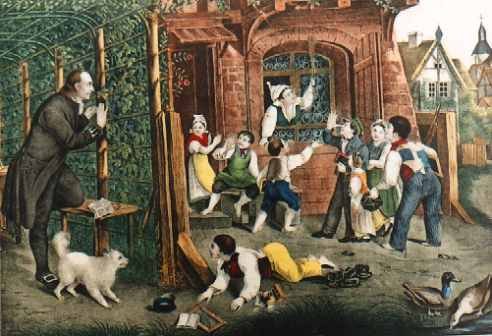Monastery, cathedral and collegiate schools
For medieval monasteries, it was considered desirable to have not only a library and writing workshop, but also a school that educated the monastery offspring, but was also accessible to laypeople. After acquiring basic knowledge of ABC, writing, church singing, church accounts and psalms, the advanced students began studying "Septem Artes liberales", of the seven liberal arts on the curriculum: grammar, rhetoric, dialectic, mathematics, arithmetic, geometry, music and astronomy. Comparable schools were established at bishopric seats.
Ritter Education
To the knight education Confined miners went through a non-written school unlike the novice novice. He had to go to the "Septem probitates", try out the seven skills: swimming, riding, darts, fencing, hunting, playing chess and verses. The handling of music, poetry and foreign languages was cultivated at knightly courts by the aristocratic ladies and probably brought them up to them by the children.
Urban schools
With the development of the cities from 1200 onwards, schools were set up under magistrate sovereignty "Magister", "rector" or "schoolmaster" one who gave lessons with his apprentices. The language of instruction was originally Latin; the curriculum was similar to that of the cathedral schools. At the urging of parents, classes were increasingly taught in German. There was one in cities with Jewish communities "Jewish school", who shared the fate of their community.
angle schools
Written management in the flourishing trade since the 13th century required simple writing and arithmetic skills for craftsmen. Men who could write and do arithmetic offered classes against payment in their apartment with the permission of the magistrate: This is how angle schools were created. Children as well as adults could be students of such schools. Attending school took so long until you could learn what you wanted to learn. The language of instruction was German.
Traveling scholars
There was in the Middle Ages "traveling scholars". These were schoolchildren who aspired to a higher education, did not find a suitable option at their place of residence and therefore moved alone or in groups from school to school across half of Europe. They had to go to school at their respective places of residence. Their support through donations was seen by the people as "good work" on; begging and aid also contributed to the livelihood of the scholars.
sexton schools
Following the Reformation, it initially spread in Protestant parishes in the 16th century "German" Rural schools. You should impart the knowledge necessary for reading the Bible. Anyone who was harmless and had the appropriate knowledge could be elected as a teacher. The pastor led the school supervision. Often it was former soldiers or artisans who did the ministry and tried to teach the village children to spell, read, catechism and hymns in their living room or from house to house. Usually no calculations were made.
Latin schools
While there was at most only elementary education in the countryside, urban Latin schools have offered the necessary training for church and public office since the mid-16th century. The school regulations regulated school life with discipline and rigor. The teachers were often theologians who waited for pastorships or felt that they were called to teach. Latin, Greek and Hebrew texts were read, which explained history and literature at the same time. Realities and mathematics often played a subordinate role.

The village school teacher, lithograph around 1835
Rural elementary school
Despite all the decrees of the sovereigns to introduce compulsory schooling as early as the 18th century, all children were only reached by school in the course of the 19th century. Unlike in the city, the predominantly one-class village school in the country dominated the picture, in which a teacher taught up to 100 pupils of different ages. Compared to the municipal elementary school, the subject matter was limited in the subjects reading, writing, religion, singing and arithmetic. Only from 1872 was the hourly table modernized, religion restricted and the realities (natural science, geography, patriotic history) expanded.
sewing schools
to "Raising general prosperity and business diligence" In the 18th century, the authorities issued orders in many places to set up schools which – after normal school – were supposed to impart practical knowledge. The teacher gave the lesson or another honorable, suitable personality. The village girls were believed "from the street".
Municipal elementary school
With elementary school "in Germany it is common to designate those schools which are designed to:. to teach the large mass of school-age children and make them indispensable. instruct respected elementary knowledge and skills." (Quote, 1875) These schools usually had three or more classes in the cities and were partly well equipped. They were a special form in the industrial centers that emerged in the 19th century "poor schools", who did not charge school fees from poor parents.
citizen schools
Neither the old Latin schools or humanistic high schools nor the lower German schools were sufficient for the common people to meet the aspiring bourgeoisie of the early 19th century. Self-confident city officials, lawyers and businesspeople campaigned for citizens’ schools in which their children – mostly boys – were given practical instruction by teachers with pedagogical requirements using selected teaching aids. While Citizen schools to the "secondary schools", the forerunners of today’s junior high schools are expected to go "Higher civil schools" in "Realgymnasiums " and "Upper secondary schools" on.
secondary schools
Real schools already existed in the 18th century, but only towards the end of the 19th century did the so-called middle schools, as forerunners of today’s secondary and vocational schools, take into account the needs of commercial life such as newer foreign languages or commercial arithmetic. This and the fact that for a long time only high school graduates after the Tertia "Annuals" (= Reduction of the military time to one year), most parents had the high school prefer for their sons. Until the 20th century, the daughters were rather sent to middle school. The uniform designation has been in use for schools of this type since 1959 "secondary school".

Corporal punishment was forbidden as a legal punishment in schools until around 1960. Even in the 19th century it was said: "The ruthe is most suitable for corporal punishment."
Lithograph, around 1835
high school
In the successor of the Latin schools, but especially due to the standardization of the high school diploma in 1812, the high school gradually crystallized as "the" Educational institution for all careers in higher civil service and the free Professions out. The main pillars of the training were the classical languages, the focus was on ancient culture. In addition, higher schools developed in the 19th century, which were more oriented towards modern languages and the natural sciences, but were only allowed to start studying at universities in 1900.
private lessons
Children from a better home were glad to be taught by a tutor, a mayor, or a governess; until 1920 these children were exempt from compulsory schooling. Despite demanding requirements with scant salaries, many university graduates were forced to serve as private tutors in the 19th century. For educated, unmarried women, working as an educator or governess was one of the few ways to earn a living. A community education for "higher daughters" took place in the numerous boarding houses and institutes.
Comprehensive schools
Due to the enormous need for qualified workers and the demand for more equal opportunities in the education system, integrated comprehensive schools were set up in 1969. In them all pupils who would otherwise have to attend high schools, junior high schools or secondary schools are taught together up to grade 10. You try to do justice to the different talents by offering a wide range of options. In addition to specialist lessons, there are interdisciplinary project lessons. In the so-called team group lessons, several teachers work together in a team.
RELATED ITEMS
-

ADHD and school – support, learning, teacher talks
ADHD, possibly combined with learning difficulties and developmental delays, quickly lead to frustration, fear of failure, and annoying…
-

Support for the school – les miracles de yahve – in sanguera, togo
Support for the school Les Miracles de Yahve in Sanguera, Togo Awako e.V. – School in Togo Awako e.V. is a registered, non-profit organization,…
-

The perfect school – that’s what parents, children and teachers say
The federal states repeatedly argue about what the perfect school should look like. But the real experts are rarely heard. We…
-

How well are children prepared for their future today? Is everything great today? How do children solve problems in school today, how is theirs…
